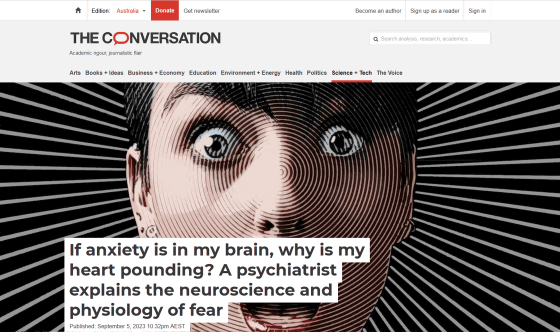Why do people feel their heart pounding or feel discomfort in their stomach and intestines when they feel fear or anxiety?

The brain processes human emotions and thoughts, but when we feel fear or anxiety, our heart often pounds, our stomach feels sick, and changes occur not in our heads but in our bodies.
If anxiety is in my brain, why is my heart pounding? A panic explains the neuroscience and physiology of fear
https://theconversation.com/if-anxiety-is-in-my-brain-why-is-my-heart-pounding-a-psychiatrist-explains-the-neuroscience-and-physiology-of-fear-210871

Many cultures use words that link fear and anxiety to the heart and internal organs, such as 'my heart feels like it's going to jump out of my throat' and 'my stomach feels sick.' On the other hand, science has traditionally seen the brain as the place where fear and anxiety are processed, and at first glance these statements seem untrue. However, Javanbach said, ``Research shows that emotions originate in your brain, but it is your body that carries out the commands.'' It is described as causing a reaction.
The human brain has evolved to protect the body from threats such as falling rocks and predator attacks, but fear and anxiety in modern society are much more complex than when evolution was occurring. For example, in a society 50,000 years ago, being rejected by your tribe could mean death, but today, even if you make a big mistake at work or school, you can still die. can be said to be quite low. However, the brain has difficulty recognizing these differences, and as a result, psychological fear and anxiety can cause physical reactions.

Several brain regions are involved in fear processing, the most important of which is
When faced with a threat such as ``a lion running towards me,'' individuals who can act quickly have a better chance of survival than individuals who think too much. Therefore, the amygdala has evolved to bypass brain areas related to logical thinking and can directly trigger physical reactions. In fact, when an ``angry person's face'' is displayed on a computer screen, the amygdala responds to the person who sees it, even if they are not fully aware of the object, Javanbaku says.
However, because it is difficult to constantly react physically to threats, the hippocampus, which is close to and closely connected to the amygdala , stores information about what is safe and what is dangerous, and the amygdala's response It is designed to intervene. For example, when you see a lion in a zoo or on the savannah, both situations trigger a fear response in your amygdala. However, when the animal is in a zoo, the hippocampus determines that it is safe and blocks the amygdala's response.
The prefrontal cortex , located above the eyes, is also involved in social and cognitive aspects of fear processing. For example, if you feel scared when you see a snake, your fear will subside if someone tells you that the snake is not poisonous, or if you realize that the snake is someone's gentle pet. On the other hand, even though you may have been able to talk to your boss in a neutral manner, if you hear a rumor from a co-worker that there will be a large-scale layoff, you may find yourself becoming defensive when talking to your boss. These reactions are due to the prefrontal cortex regulating fear regarding cognition and the social environment.

When the brain has justified a fear response, neuronal and hormonal pathways are activated to prepare the body for immediate action through the fight-or-flight response . Although some reactions occur within the brain, such as improving alertness or detecting threats, most reactions occur in organs other than the brain.
Some responses prepare us for intense physical activity, and the brain's motor cortex sends signals to our muscles to prepare them for quick, forceful movements. The muscles that send signals include those in the chest and abdomen that protect vital organs, and because these muscles react differently than usual, when you feel fear or anxiety, your heart and stomach are compressed. It is possible that you may feel like this.
The sympathetic nervous system also plays an important role in how the body responds, acting like an accelerator pedal that speeds up the fight-or-flight response. The sympathetic nervous system is concentrated in areas such as the heart, lungs, and intestines, and triggers the secretion of hormones such as adrenaline .
The sympathetic nervous system causes the heart to increase its rate and contraction strength in order to pump enough blood to the muscles, causing a sensation of ``pounding''. In addition, the lungs expand the airways and increase the breathing rate to secure oxygen, which can sometimes cause a feeling of shortness of breath. Digestion of low-priority food is then put on the back burner when fleeing from a threat, resulting in gastrointestinal discomfort.
These physical reactions associated with fear and anxiety are ultimately transmitted to the brain, so there are cases where physical sensations create a loop that amplifies fear and anxiety. 'Feelings of fear and anxiety begin in the brain, but they are also felt in the body as the brain changes bodily functions,' Javanbach said.
Related Posts:
in Science, Posted by log1h_ik







